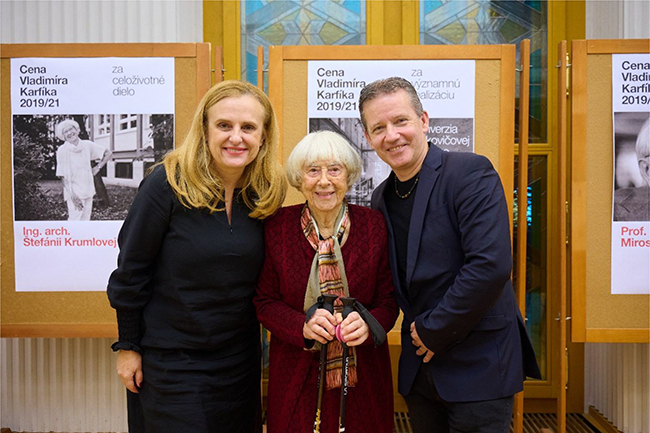
The Czechoslovak Block of Architects and Artists awarded the Vladimir Karfík Prizes for the period 2019/2021
 |
| Laureates of the V. K. Award Zuzana Zacharová, Štefánie Krumlová, and Martin Paško in Zlín |
December 13, 2022, in the ceremonial hall of the Zlín city hall, the Vladimir Karfík Awards were ceremoniously handed over by F. L. Gahura. They are awarded every three years by the Czechoslovak association BLOK of architects and artists/architects and visual artists, founded after the Velvet/Nice Revolution by architect friends from both sides of the Morava River, whose works were significant despite the normalization regime that pushed them into the background. The award, named in honor of the creation and life of its first honorary recipient, has traditionally been given with the support of the city with which Vladimir Karfík and his architecture are iconically associated. In the past, 33 personalities of Czechoslovak architecture have received the award, including, for example, Karel Prager, founder and first chairman of BLOK, Štefan Světko, Alena Šrámková, Víra Mecková, Josef Pleskot, Vladimír Dedeček, and others.
In the category for significant realization, the award was won by the authors Conversion of the Jurkovič Heating Plant, Ing. arch. Martin Paško and the DF CREATIVE GROUP team. In the laudation for BLOK, Peter Žalman highlighted the exceptional example of successful conversion of an abandoned industrial building and its incorporation into a new urban complex and the "concept of inserting a building, a new shape into the existing protected mass of the industrial building." This resulted in added value, particularly in the nearly perfect reconsideration and realization of details. Whether in the choice of materials or various architectural elements of the work. The object has precisely restored and supplemented facades based on exposed brick, which was a favored material of architect Jurkovič during his industrial phase of creation. A timeless work emerged that added original solutions to the original values, with a distinctly contemporary expression and connecting multiple functions, which became a golem-like concrete hopper that brought in new strong energy.
For lifetime achievement, the V.K. Award was received by Ing. arch. Štefánie Krumlová. A native of Bratislava (*1932), she studied architecture (1949-1955) at the Faculty of Architecture and Civil Engineering with her thesis under its founder, academician prof. Emil Belluš. She became part of a group of young women who formed the first generation of Slovak female architects at a time when architecture was predominantly a male domain. Immediately after joining the Bratislava Stavoprojekt in the team of architect Ludvík "Baldy" Jendreják, she collaborated on a 48-class school with the first exposed cable structure over a gymnasium by statician Jozef Poštulka, installed twice in Bratislava. However, her greatest contribution was particularly in preschool facilities in the centers of residential complexes and small architecture. They excelled in a playful and ingenious mass composition, small scale, and connection of interiors with exteriors. Her correct interpersonal relationships also reflected in her profession. As a collaborator of Štepán Světko, the author of the housing estate "Únor", but also as his long-time resident, she became his patron. For years, she has been trying to prevent the "thickening" of the original buildings and the destruction of its authenticity. "Eje" Krumlová, as her friends call her, is a "refreshing lady, with excellent thinking and opinions. She follows the internet, writes emails, studies computers and photography at the university for seniors for 15 years, and still remains interested in the world around her," as stated in his speech for BLOK by doc. Ivan Gürtler.
The award for lifetime achievement was also granted by BLOK to a prominent personality of the Czech architectural and social scene prof. Ing. arch. Miroslav Masák, Dr. h. c. (*1932). After graduating from the Faculty of Architecture and Civil Engineering at the Czech Technical University in Prague, he joined the Liberec Stavoprojekt, and this step determined his professional and personal life path. As a creative architect, he was often involved with colleagues from SIAL in the birth of significant buildings, such as Exhibition Pavilion F in Liberec, the department store Máj in Prague, the shopping center Ještěd in Liberec, and the reconstruction of the Trade Fair Palace of the National Gallery in Prague (for which he received the CVK in 2010). The Stavoprojekt also influenced his social and pedagogical activities. In 1968, he co-founded SIAL and its Škůlku - an independent studio of fresh architecture graduates. After August 1968, he was forced to abandon this activity, yet continued in unofficial groups. After 1989, he became an advisor to President Václav Havel, with whom he had a relationship since the time of dissent. As a creative architect, he authored works such as the reconstruction of the presidential residence in the Royal Garden of Prague Castle. He continued to educate architects as an external educator at the Faculty of Architecture of the Brno University of Technology, where he obtained the title of professor in the field of architecture in 1999. His life and work have become a permanent part of the history of Czech architecture and society in the second half of the 20th century.
The laureates, with the exception of Professor Masák's absence for health reasons, received awards from the hands of the chairman of BLOK Ing. arch. Zdeňka Trefila, the deputy mayor of the statutory city of Zlín Mgr. Pavel Brada, and the chairman of the Slovak section Ing. arch. Ruda Žákovský.
The English translation is powered by AI tool. Switch to Czech to view the original text source.
0 comments
add comment











